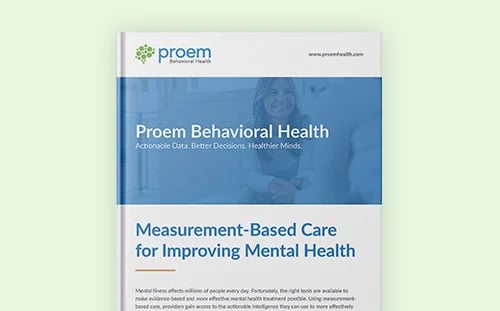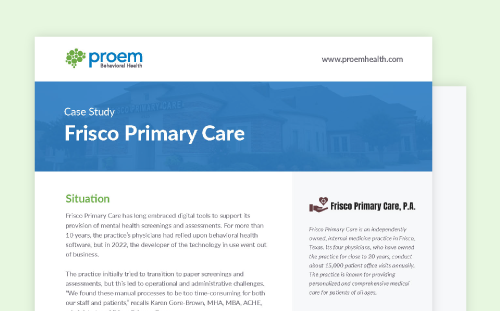The most recent National Survey of Drug Use and Health showed that approximately 18 million adults aged 18 or older in 2021 had a co-occurring mental illness and illicit drug or alcohol use disorder in the prior year.

To meet the care needs of this population, substance use disorder (SUD) clinics and mental health providers must screen all patients for co-occurring conditions, then follow up with integrated treatment plans. The first step to effectively addressing the overlap is to understand the connection between these types of disorders.
How Addiction Affects Mental Health
Substance use and mental illness have a complex, bidirectional relationship. Substance use may trigger neurological changes in some individuals, leading to mental illness. For instance, young people with cannabis use disorder are significantly more likely to develop schizophrenia. Substance use may also trigger the escalation of mood disorder symptoms to the clinical level, effectively “unmasking” a disorder that may have gone unnoticed.
The connection also works in the other direction when patients use substances to alleviate mental health symptoms. In one study, between 21.9% and 24.1% of individuals with mood or anxiety disorders engaged in this pattern of self-medication.
While mental illness can trigger disordered substance use and vice versa, identifying a causal pathway is difficult. According to the National Institute of Mental Health (NIMH), both disorder types have common social, emotional and physical risk factors, from genetic predispositions to stress experiences. Additionally, active SUD and mental illness affect one another, creating a clinical picture unique to the individual.
It’s important for providers treating SUD and mental illness to understand how addiction affects mental health while recognizing the need for integrated SUD mental health treatment.
SUD Mental Health Care: The Integrated Approach
Given the prevalence and complexity of co-occurring disorders, it no longer makes sense to silo SUD and mental health treatment. Providers must assess for the possibility of mental illness in each SUD patient and vice versa.
An integrated treatment approach enables patients to receive care for mental health and addiction issues from a single team and with a unified treatment plan. Instead of shuttling back and forth between mental health providers and substance use disorder clinics — or receiving treatment for one disorder while the other goes unnoticed or untreated — patients work with a team that oversees all aspects of their treatment journey.
The Substance Abuse and Mental Health Services Administration (SAMHSA) recommends this approach as the best practice for providing concurrent mental health and addiction treatment. In the application of this model, an integrated treatment specialist works within a multidisciplinary team.
Integrated mental health and addiction treatment can target the patient’s unique clinical situation and incorporate critical considerations, such as trauma histories and the need for addiction treatment medications.
Advantages of Trauma-Informed Care
Mental illness and SUD are common among trauma survivors, as are underdiagnosis and misdiagnosis of trauma histories. Integrated treatment makes it easier for providers to provide trauma-informed care at all stages of recovery.
Trauma-informed care recognizes the impact of trauma on an individual’s mental health and addiction. It incorporates that understanding into the person’s treatment plan, creating a safe space where people can recover without fear of re-traumatization.
SAMHSA recommends integrated trauma-informed care for all trauma survivors with co-occurring addiction and mental health needs. Evidence suggests this approach is more effective at reducing symptoms and improving quality of life. By addressing the impact of trauma, providers can develop and implement the proper treatment for each patient.
Role of Medication-Assisted Treatment (MAT)
Many individuals with SUD mental illness overlap may benefit from medication as part of their treatment protocol. Medications can support recovery in various ways. For example:
- Buprenorphine suppresses cravings for opioids.
- Methadone reduces cravings and blunts opioid effects.
- Naltrexone prevents euphoric experiences after using opioids or alcohol.
- Disulfiram inhibits the pleasurable effects of alcohol intoxication to improve recovery motivation.
Research has shown that treatment with approved medication reduces the risk of death among people with opioid use disorder (OUD). These medications can also improve social functioning, reduce the use of other illicit drugs and improve a patient’s quality of life. Providers across different care settings can work together on appropriate medication management.
Coordinating Care Delivery for Better Outcomes
Effective integrated care requires providers and clinics to work together and develop plans with the patient at the center.
Education and skills training
Data has indicated that serious mental illnesses are as prevalent and severe among individuals in SUD clinics as in mental health treatment facilities. Likewise, substance use disorders are equally common and severe in mental health and SUD clinics.
Unfortunately, providers often miss the opportunity to evaluate or treat co-occurring conditions despite these commonalities. In “Improving the Quality of Health Care for Mental and Substance-Use Conditions,” the National Institutes of Health describes historically separate treatment systems, with providers in one category often failing to offer treatment or appropriate referrals for the other diagnosis type.
The separation is institutional and systemwide. It has left many healthcare providers without sufficient understanding of SUD and mental illness — distinct or co-occurring. This gap includes staff of substance use disorder clinics and mental health treatment centers, all of whom would benefit from formal training on the interplay between mental health and addiction. Workplace education is an essential step to closing this treatment gap.
Dual-diagnosis screening
Effective treatment also depends on accurate diagnoses for those struggling with mental health and addiction. The 2021 National Survey on Drug Use and Health revealed that out of the roughly 18 million adults and 850,000 adolescents needing treatment for an SUD and mental health condition, nearly half of each population did not receive either treatment. Among those who did receive treatment, the vast majority received only mental health care.
Comprehensive screening using evidence-based behavioral health tools can close this gap. As SAMHSA notes in its treatment improvement protocol for trauma-informed care, “Behavioral health professionals without specific assessment training can still serve an essential role in screening for possible mental disorders using established screening tools. In agencies and clinics, it is critical to provide such screenings systematically — for each client — as PTSD and other co-occurring disorders are typically underdiagnosed or misdiagnosed.”
The key is to implement universal screenings for SUD and mental illness for all patients, both in general practice and mental health or substance use clinics.
The SUD Mental Health Overlap: Proem Helps with Screening
To effectively assess and treat co-occurring mental health and addiction disorders, clinics must add universal screening to their standard workflow. Proem makes this integration easy with an evidence-based behavioral health solution centered on gold-standard, integrated measurements accessible to patients and providers.
Clinics can add these routine, licensed digital screenings and assessments into their standard intake or appointment workflows for every patient, reducing the chances of missed or incorrect diagnoses. Our end-to-end system makes it simpler to coordinate care within a clinic and with other provider facilities, thus improving the quality of services patients receive. Connect with Proem today to learn how we can help you.





.png)









